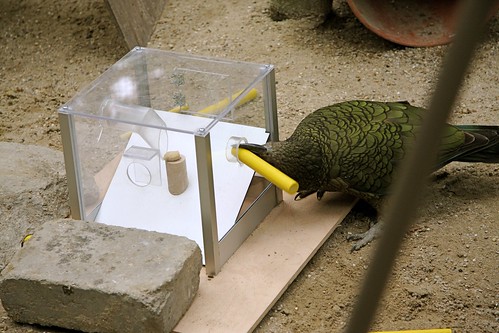In a cognitive show-down between two of the most intelligent bird species—the New Zealand kea and the New Caledonian crow—which would win? New research put these species to the test, comparing their ability to quickly solve puzzles and adapt to obstacles. As it turns out, the answer is a bit more complicated that you’d expect.
The kea, a small green parrot with bright red under wings, hails from the mountains of New Zealand where it faces few threats in the wild. Though keas are not known to use tools in the wild, they are famous for a keen curiosity that sometimes borders on vandalism. They’ve been known to tear apart car windshield wipers and disassemble picnic baskets in their urge to explore. Crows, on the other hand, are notoriously neophobic—they experience an acute paranoia for new things. Crows are expert tool-users in the wild, though. Their short, straight beaks allow them to pick up sticks to cautiously probe unknown objects or adroitly swab for grubs in tree bark and dead wood.
Both parrots and crows show “outstanding innovative and flexible behavior” and “exceptionally sophisticated cognition” that is sometimes compared with the tool-wielding abilities of great apes, write researchers in a paper published this week in the journal PLoS One. But just because they’re both smarty-pants amongst their avian peers doesn’t mean an apples-to-oranges—or in this case crow-to-parrot—direct comparison is fair. Adjustments to even the playing field amongst species had to be made.

Researchers presented six kea and five crows with a fair and square challenge. An irresistible birdy treat was placed within a transparent cube for the birds to examine at their own leisure. Rather than just having one means of accessing the treat, each side of the box featured a different puzzle for attaining the goodies inside. The birds could chose between pulling a string tied around the treat, tugging a hook-shaped lever to open a window, inserting a marble into a slide that led towards the reward, or poking a stick-like tool into a hole to push the food out of the box. After a bird solved a certain side of the puzzle, that side was blocked off, forcing the animal to figure out a new way of earning the coveted snack.
Both species started out on the same wing, bee lining for the prize-on-a-string option. From there, though, their preferred puzzle paths diverged, as did the time it took them to transition between the tasks. The exercises became increasingly challenging for the birds, and out of the six kea and five crows, only one bird of each group figured out all four puzzles. Kermit the kea and Uek the crow were the respected winners.


Uek the crow quickly discovered the stick tool. Once she had it in her beak, she went to town exploring and probing the box from a distance instead of touching the unknown cube directly. Uek’s biggest challenge was the window task. It took her a while to work up the courage to open the window, and once that was done she refused to stick her head into the box and instead used the stick to poke the food off the platform.
Given the ecological, physiological, and behavioral background of the two birds, the results make sense. Keas are quick to try new things and jump in beak first, but they don’t face the same dangers in their natural environment as crows. Uek and her crow friends’ caution compliments their intelligence by serving as an asset in their oftentimes dangerous natural environment. Researchers correctly hypothesized that a single task would have obscured the abilities of the two species since their strengths and weakness differ. Employing four different challenges allowed a more robust and fair comparison of problem solving abilities both between individuals and species.

As the researchers conclude, individuals as well as species will outperform each other in different ways. Ultimately, researchers hope to gain more insight into the evolution of intelligence by examining the interesting personalities and propensities of these two highly intelligent bird families.
